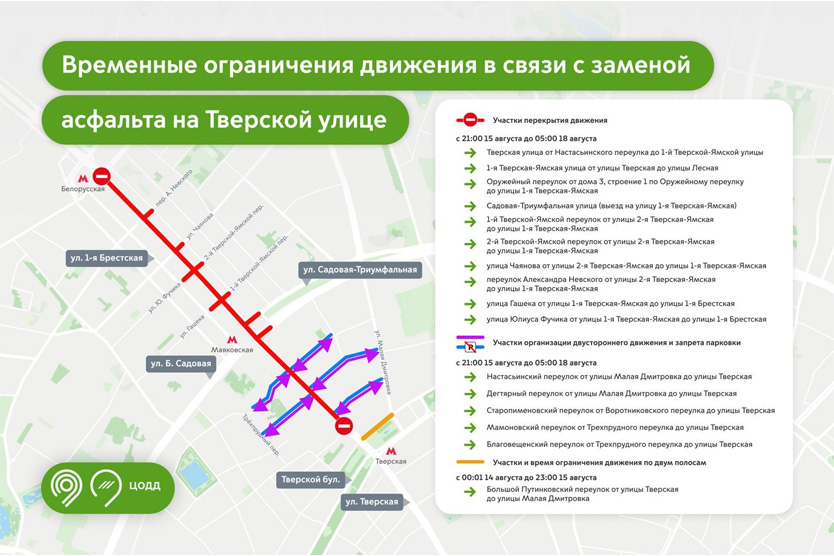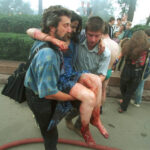Work will begin on August 15 at 9:00 PM. Specialists will replace approximately 50,000 square meters of pavement. The asphalt will be laid in a continuous layer across the entire width of the roadway. The main phase of the work is scheduled for the weekend when traffic is lighter. The repairs are expected to be completed by August 18 at 5:00 AM.
- The last pavement renewal on this section of Tverskaya Street took place in 2021. Thanks to seamless laying, the surface lasted four seasons without repairs. According to standards, the lifespan of asphalt on first-category roads, which includes Tverskaya, is three years. Currently, due to heavy traffic, rutting has formed on the roadway.
During the repairs, traffic will be blocked on the following sections:
- Tverskaya St. (from Nastasyinsky Lane to 1st Tverskaya-Yamskaya);
- 1st Tverskaya-Yamskaya (from Tverskaya to Lesnaya);
- Sadovaya-Triumfalnaya (exit to 1st Tverskaya-Yamskaya);
- Chayanova St. (from 2nd Tverskaya-Yamskaya to 1st Tverskaya-Yamskaya);
- Gashek St. (from 1st Tverskaya-Yamskaya to 1st Brestskaya);
- Julius Fucik St. (from 1st Tverskaya-Yamskaya to 1st Brestskaya).
Restrictions will also affect other areas: 1st and 2nd Tverskaya-Yamskaya Lanes, Oruzheiny Lane, as well as Alexander Nevsky Lane. Until 11:00 PM on August 15, two lanes in Bolshoy Putinkovsky Lane will be closed from Tverskaya to Malaya Dmitrovka.
Two-way traffic will be introduced in several lanes, and temporary parking bans will be enforced. This applies to Nastasyinsky, Degtyarny, Staropimenovsky, Mamonsky, and Blagoveshchensky Lanes.
Tverskaya Street
Tverskaya Street is one of Moscow’s oldest and most famous avenues, dating back to the 12th century. Originally a major trade route connecting Moscow to Tver and later St. Petersburg, it became a prestigious residential and commercial hub under the Russian Empire and the Soviet Union. Today, it is a vibrant thoroughfare lined with historic buildings, luxury shops, and cultural landmarks, reflecting Moscow’s evolution over centuries.
Nastasyinsky Lane
Nastasyinsky Lane is a historic street in central Moscow, known for its charming 19th-century architecture and quiet, picturesque atmosphere. It was named after the Church of St. Anastasia, which once stood here but was demolished during the Soviet era. Today, the lane retains its old-world charm and is surrounded by cultural landmarks, including theaters and museums.
1st Tverskaya-Yamskaya
1st Tverskaya-Yamskaya Street is a historic thoroughfare in central Moscow, originally established in the 17th century as part of the road connecting Moscow to Tver. It was named after the *yamskaya sloboda* (postal station settlement) where coachmen and postal services operated. Today, it is a bustling street blending old architecture with modern businesses, reflecting Moscow’s evolution from a trading route to a vibrant urban center.
Lesnaya
“Lesnaya” (which means “forest” in Russian) is a small village in Belarus, historically known for the Battle of Lesnaya in 1708 during the Great Northern War, where Russian forces led by Peter the Great defeated the Swedes. Today, it is a quiet rural area with a memorial complex commemorating the battle. The site serves as a reminder of Russia’s military history and its influence in Eastern Europe.
Sadovaya-Triumfalnaya
Sadovaya-Triumfalnaya is a street in central Moscow, Russia, known for its historical and cultural significance. The area dates back to the 18th century and was once part of the bustling Garden Ring, a major circular road surrounding the city center. Today, it features a mix of architectural styles, theaters, and landmarks, reflecting Moscow’s rich urban heritage.
Chayanova St.
Chayanova Street is a notable thoroughfare in Moscow, Russia, named after the Soviet economist Alexander Chayanov. Located in the Presnensky District, it is known for its mix of historic and modern architecture, reflecting Moscow’s urban evolution. The street is part of a vibrant area with cultural and commercial significance, though it does not have the deep historical legacy of some older Moscow streets.
Gashek St.
“Gashek St.” (Улица Гашека) is a street in Moscow, Russia, named after Jaroslav Hašek, the Czech writer famous for his satirical novel *The Good Soldier Švejk*. The street is located in the Chertanovo Severnoye district and reflects Moscow’s tradition of naming streets after notable cultural figures. While not a major tourist site, it honors Hašek’s literary legacy and the cultural ties between Russia and the Czech Republic.
Julius Fucik St.
Julius Fučík Street is a notable thoroughfare in Prague, Czech Republic, named after Julius Fučík, a Czechoslovak journalist, communist, and anti-Nazi resistance hero executed during World War II. The street reflects Prague’s modern urban development and commemorates Fučík’s legacy, though his historical reputation has been debated since the fall of communism. Today, it serves as a functional artery in the city, blending residential and commercial spaces.




